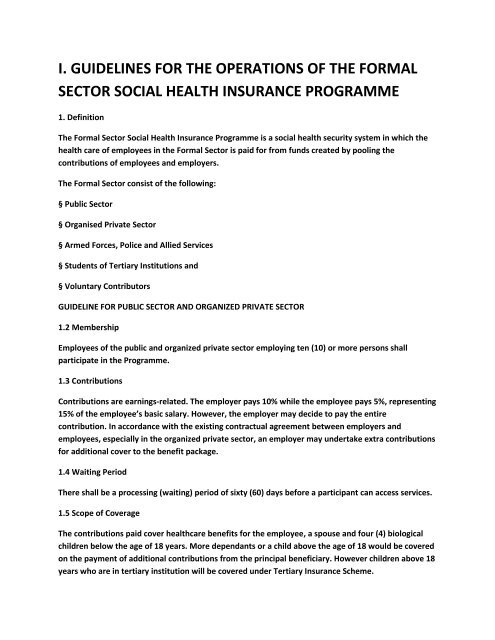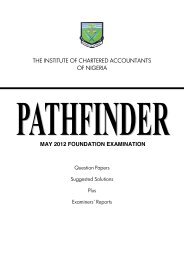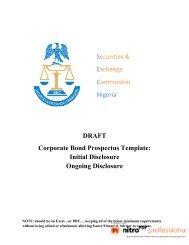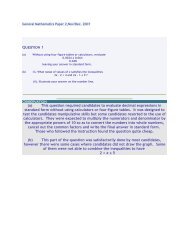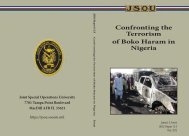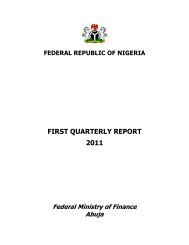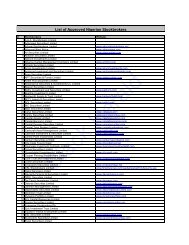Operational Guidelines for NHIS - Resourcedat
Operational Guidelines for NHIS - Resourcedat
Operational Guidelines for NHIS - Resourcedat
You also want an ePaper? Increase the reach of your titles
YUMPU automatically turns print PDFs into web optimized ePapers that Google loves.
I. GUIDELINES FOR THE OPERATIONS OF THE FORMALSECTOR SOCIAL HEALTH INSURANCE PROGRAMME1. DefinitionThe Formal Sector Social Health Insurance Programme is a social health security system in which thehealth care of employees in the Formal Sector is paid <strong>for</strong> from funds created by pooling thecontributions of employees and employers.The Formal Sector consist of the following:§ Public Sector§ Organised Private Sector§ Armed Forces, Police and Allied Services§ Students of Tertiary Institutions and§ Voluntary ContributorsGUIDELINE FOR PUBLIC SECTOR AND ORGANIZED PRIVATE SECTOR1.2 MembershipEmployees of the public and organized private sector employing ten (10) or more persons shallparticipate in the Programme.1.3 ContributionsContributions are earnings-related. The employer pays 10% while the employee pays 5%, representing15% of the employee’s basic salary. However, the employer may decide to pay the entirecontribution. In accordance with the existing contractual agreement between employers andemployees, especially in the organized private sector, an employer may undertake extra contributions<strong>for</strong> additional cover to the benefit package.1.4 Waiting PeriodThere shall be a processing (waiting) period of sixty (60) days be<strong>for</strong>e a participant can access services.1.5 Scope of CoverageThe contributions paid cover healthcare benefits <strong>for</strong> the employee, a spouse and four (4) biologicalchildren below the age of 18 years. More dependants or a child above the age of 18 would be coveredon the payment of additional contributions from the principal beneficiary. However children above 18years who are in tertiary institution will be covered under Tertiary Insurance Scheme.
1.6 Benefit PackageHealthcare providers under the Scheme shall provide the following benefit package to thecontributors:i) Out-patient care, including necessary consumables;ii) Prescribed drugs, pharmaceutical care and diagnostic tests as contained in the National EssentialDrugs List and Diagnostic Test Lists;iii) Maternity care <strong>for</strong> up to four (4) live births <strong>for</strong> every insured contributor/couple in the FormalSector Programme;iv) Preventive care, including immunization, as it applies in the National Programme on Immunization,health education, family planning, antenatal and post-natal care;v) Consultation with specialists, such as physicians, pediatricians, obstetricians, gynaecologists,general surgeons, orthopaedic surgeons, ENT surgeons, dental surgeons, radiologists, psychiatrists,ophthalmologists, physiotherapists, etc.;vi) Hospital care in a standard ward <strong>for</strong> a stay limited to cumulative 15 days per year. Thereafter, thebeneficiary and/or the employer pays. However the primary provider shall pay per diem <strong>for</strong> bed space<strong>for</strong> a total 15 days cumulative per year.vii) Eye examination and care, excluding the provision of spectacles and contact lenses;viii) A range of prostheses (limited to artificial limbs produced in Nigeria); andix) Preventive dental care and pain relief (including consultation, dental health education, amalgamfilling, and simple extraction).Note: All Providers are expected to provide counselling as an integral part of quality care.1.7 Registration of Employers and Employees(a) Every employer shall register with the <strong>NHIS</strong>, upon which a registration number shall be allotted toit by the Scheme.(b) Every employer shall appoint an <strong>NHIS</strong>-registered Health Maintenance Organisation (HMO) of theirchoice.(c) Every registered employer shall supply the following in<strong>for</strong>mation to the Scheme and to theappointed HMO:(i) Name of employer,(ii) Category of employer (public or private),
(iii) Management structure of the organization, and(iv) Staff lists, including basic salaries.(d) The employee shall register self, a spouse and four (4) biological children below the age ofeighteen (18) years with the Scheme.2. GUIDELINES FOR THE ARMED FORCES, POLICE AND ALLIED SERVICES2.1 DEFINITIONThe Armed Forces, Police and Allied Services Social Health Insurance Programme is a social securitysystem where the health care of members is paid <strong>for</strong> by the Federal Government.2.2 MEMBERSHIPAll members of the Armed Forces, the Nigeria Police Force, Nigerian Customs Service, NigerianImmigration Service, Nigerian Prisons Service and other Federal uni<strong>for</strong>med services.2.3 CONTRIBUTIONContributions to be paid are earnings related. This currently equates to 15% of the basic salary of theparticipants. The Federal Government shall be responsible <strong>for</strong> payment of the contributions.2.4 SCOPE OF COVERAGEThe contributions paid on behalf of a participant under this Programme covers provision of healthbenefits <strong>for</strong> the participant, five dependants consisting a spouse, four children below the age of 18years.2.5 BENEFIT PACKAGEThe benefits derivable to participants and their dependants include the following:§ Outpatient care (including consumables)§ Prescribed generic drugs, pharmaceutical care as contained in the National Essential Drug List;§ Diagnostic tests as contained in the Diagnostic Tests List§ Maternity care <strong>for</strong> up to four (4) live births <strong>for</strong> every insured contributor/couple;§ Preventive care including immunisation as it applies in the National Programme on Immunisation,health education, family planning, antenatal and post-natal care;
§ Consultations with specialists, such as physicians, paediatricians, obstetricians, gynaecologists,general surgeons, orthopaedic surgeons, ENT surgeons, dental surgeons, radiologists, psychiatrists,ophthalmologists, physiotherapists, etc.;§ Hospital care in a standard ward <strong>for</strong> a stay limited to a cumulative of 28 days stay (after the 15 dayscovered by capitation), <strong>for</strong> physical and mental disorders. Thereafter the beneficiary or the FederalGovernment pays;§ Eye examination and care, excluding the provision of spectacles and contact lenses;§ A range of prostheses (limited to artificial limbs produced in Nigeria); and§ Preventive dental care and pain relief (including consultation, dental health education, amalgamfilling, and simple extraction).Note: All Providers are expected to provide counselling as an integral part of quality care.3. GUIDELINES FOR STUDENTS IN TERTIARY INSTITUTIONS3.1 DEFINITIONSocial Health Insurance Programme <strong>for</strong> students in Tertiary Institutions is a social security systemwhere the health care of students is paid <strong>for</strong> from funds created by pooling of contributions ofparticipating students and Institutions.3.2 MEMBERSHIPMembership is <strong>for</strong> students (full and part-time) of Federal, State and Private Tertiary Institutions.3.3 CONTRIBUTIONInstitutions and students will contribute an actuarially determined rate always at the point ofpayment of School fees.3.4 SCOPE OF COVERAGEContribution paid entitles participating student to a health care benefit package shown below.3.5 BENEFIT PACKAGEThe benefits derivable to participants include the following:i) Out-patient care, including necessary consumables;ii) Prescribed drugs, pharmaceutical care and diagnostic tests as contained in the National EssentialDrugs List and Diagnostic Test Lists;
iii) Maternity care <strong>for</strong> up to four (4) live births <strong>for</strong> every insured contributor.iv) Preventive care, including immunization, as it applies in the National Programme on Immunization,health education, family planning, antenatal and post natal care;v) Consultation with specialists, such as physicians, pediatricians, obstetricians, gynaecologists,general surgeons, orthopaedic surgeons, ENT surgeons, dental surgeons, radiologists, psychiatrists,ophthalmologists, physiotherapists, etc.;vi) Hospital care in a standard ward <strong>for</strong> a stay limited to cumulative 15 days per year. Thereafter, thebeneficiary and/or the employer pays. However the primary provider shall pay per diem <strong>for</strong> bed space<strong>for</strong> a total 15 days cumulative per year.vii) Eye examination and care, excluding the provision of spectacles and contact lenses;viii) A range of prostheses (limited to artificial limbs produced in Nigeria); andix) Preventive dental care and pain relief (including consultation, dental health education, amalgamfilling, and simple extraction).Note: All Providers are expected to provide counselling as an integral part of quality care.ADMINISTRATIONAll Tertiary Institutions shall remit the contribution of both the student and the institution to the NHIFund at the beginning of each academic year. The <strong>NHIS</strong> will appoint a Health MaintenanceOrganisation (HMO) registered and accredited by the Scheme <strong>for</strong> the purpose of health caremanagement. The HMO shall be responsible <strong>for</strong> paying the Provider <strong>for</strong> services rendered and shallalso be responsible <strong>for</strong> maintaining quality assurance in the delivery of health care services under theprogramme.Students can be registered with accredited Health Centres of the Institutions, or any public or privateaccredited primary health care facilities of their choice <strong>for</strong> all their health care needs.4. GUIDELINES FOR VOLUNTARY CONTRIBUTORS4.1 MEMBERSHIPMembership is <strong>for</strong> interested individuals who are not currently covered by any <strong>for</strong>m of social healthinsurance. These include:(a) An employer with less than ten employees in its service, or any self-employed person(s), who arenot subject to the Act setting up the Scheme.(b) Retirees who wish to continue under the <strong>NHIS</strong> Formal Sector Programme.
(c) Nigerians in Diaspora4.2 CONTRIBUTIONSContributions will be paid on individual basis, monthly and in advance.4.3 SCOPE OF COVERAGEContributions paid entitle only the participant to a health care benefit package.4.4 BENEFIT PACKAGEHealthcare providers under the Scheme shall provide the following benefit package to thecontributors:i) Out-patient care, including necessary consumables;ii) Prescribed drugs, pharmaceutical care and diagnostic tests as contained in the National EssentialDrugs List and Diagnostic Test Lists;iii) Maternity care <strong>for</strong> up to four (4) live births <strong>for</strong> every insured contributor/couple in the FormalSector Programme;iv) Preventive care, including immunization, as it applies in the National Programme on Immunization,health education, family planning, antenatal and post-natal care;v) Consultation with specialists, such as physicians, pediatricians, obstetricians, gynaecologists,general surgeons, orthopaedic surgeons, ENT surgeons, dental surgeons, radiologists, psychiatrists,ophthalmologists, physiotherapists, etc.;vi) Hospital care in a standard ward <strong>for</strong> a stay limited to cumulative 15 days per year. Thereafter, thebeneficiary and/or the employer pays. However the primary provider shall pay per diem <strong>for</strong> bed space<strong>for</strong> a total 15 days cumulative per year.vii) Eye examination and care, excluding the provision of spectacles and contact lenses;viii) A range of prostheses (limited to artificial limbs produced in Nigeria); andix) Preventive dental care and pain relief (including consultation, dental health education, amalgamfilling, and simple extraction).Note: All Providers are expected to provide counselling as an integral part of quality care.4.5 ADMINISTRATIONHealth Maintenance Organization (HMOs) registered and accredited by the Scheme shall beresponsible <strong>for</strong> collecting the contributions of participants, paying the Provider <strong>for</strong> services renderedand maintaining quality assurance in the delivery of health care services under the programme.
Registered participants are then registered with a Primary Health Care Provider who they will consult<strong>for</strong> all their health care needs.5. CATEGORIES OF HEALTHCARE PROFESSIONALS UNDER THE <strong>NHIS</strong>(a) General Medical Practitioners(b) Specialist Medical Practitioners(c) Pharmacists(d) Nurses/Midwives(e) Laboratory Scientists(f) Radiographers(g) Physiotherapists(h) Dental Surgeons(i) Community Health workers6. GENERAL REQUIREMENTS FOR HEALTH CARE PROVIDERS (HCPs)· Possession of the relevant academic qualifications in the field of endeavour;· Registration with the relevant professional body;· Possession of the current licence to practice;· Appropriate facility <strong>for</strong> service delivery;· Registration by state authorities (where necessary); and· Possession of malpractice insurance cover.7. REQUIREMENTS FOR HEALTHCARE PROFESSIONALS(a) General Medical Practitioners(i) Possession of the Bachelor of Medicine, Bachelor of Surgery (MBBS) degree, or its equivalent,recognized by the Medical and Dental Council of Nigeria;
(ii) Registration with the Medical and Dental Council of Nigeria; and(iii) Possession of the current licence to practise, issued by the Medical and Dental Council of Nigeria(MDCN).(b) Specialist Medical PractitionersThey include: physicians, dental surgeons, radiologists, paediatricians, psychiatrists, surgeons,gynaecologists, ENT surgeons, ophthalmologists, etc.Possession of recognised specialist qualifications in the proposed area of practice in addition to (a)above.7(c) Pharmacists(i) Possession of the Bachelor of Pharmacy (B.Pharm) degree or equivalent qualification, recognized bythe Pharmacists Council of Nigeria (PCN); and(ii) Possession of the professional licence to practise, issued by the Pharmacists Council of Nigeria(PCN).(d) Medical Laboratory Scientists(i) Possession of the Bachelor of Medical Laboratory Science (BMLS) degree or equivalentqualification, recognized by the Medical Laboratory Science Council of Nigeria (MLSCN);(ii) Registration with the MLSCN; and(iii) Possession of the current licence to practise, issued by the MLSCN.(e) Nurse Practitioners(i) Double qualifications (i.e., Nursing and Midwifery or other specialized areas of Nursing);(ii) Registration by the Nursing and Midwifery Council of Nigeria (NMCN); and(iii) Possession of the current licence to practise, issued by the NMCN.(f) Radiographers and Ultrasonographers(i) Possession of the Bachelor of Radiography degree, or equivalent qualification, recognized by theNigerian Council of Radiographers (NCR);(ii) Registration with the NCR; and(iii) Possession of the current licence to practise, issued by the NCR.
(g) Physiotherapistsi) Possession of the Bachelor of Science in Physiotherapy degree, or equivalent qualification,recognized by the Medical Rehabilitation Board of Nigeria (MRBN);ii) Registration with the MRBN; andiii) Possession of the current licence to practise, issued by the MRBN.(h) Dental Surgeons(i) Possession of the Bachelor of Dental Surgery degree, or equivalent qualification, recognized by theMedical and Dental Council of Nigeria (MDCN);ii) Registration with the MDCN; andiii) Possession of the current licence to practice issued by the MDCN.(i) Community Health Workersa) Community Health Officersi) Must have completed a 12-month course <strong>for</strong> Community Health Officer course in an approvedUniversity Teaching Hospital or College of Health Technology as additional to qualification in (b) and(c) below.ii) Must be registered by Community Health Practitioners Registration Board of Nigeria (CHPRBN)iii) Possesses a current licence to practice by the CHPRBNiv) Must have the Standing Orders from Federal Ministry of Health <strong>for</strong> Community Health Officers andCommunity Health Extension Workersb) Senior Community Health Extension Workersi) Must have completed a 36 month course <strong>for</strong> Community Health Extension Worker in an approvedHealth Institutionii) Must have complied with (a) ii – ivc) Junior Community Health Extension Workersi) Must have completed a 24-month course <strong>for</strong> Junior Community Health Extension Worker in anapproved Health Institution.ii) Must have complied with (a) ii - iv
8. REGISTRATIONRegistration of Employers and Employees:a) Every Employer shall register with the <strong>NHIS</strong>, upon which a registration number shall be allotted toit by the Scheme.b) Every Employer shall appoint an <strong>NHIS</strong> registered Health Maintenance Organisation (HMO) of theirchoice.c) Every registered employer shall supply the following in<strong>for</strong>mation to the Scheme and to theappointed HMO;i) Name of Employerii) Category of Employer (Public or Private)iii) Management Structure of the organization andiv) Staff List, including basic salariesd) Employee shall register self, a spouse and four (4) biological children below the age of eighteen (18)years with the Scheme.9. IDENTITY CARDSa) Identity cards shall be issued by the Scheme at a cost.b) It shall be replaced when necessary.c) It shall bear the beneficiary’s name, gender, address, registration number, photograph, thumbprint,date of birth, blood group, allergies, date of issue, HMOs code, authorized signature etc.10. POOLING OF CONTRIBUTIONSa) PUBLIC SECTOR: All contributions (Employers/Employees) shall be paid directly to the HMOs by the<strong>NHIS</strong> Fund quarterly and in advance.b) PRIVATE SECTOR: Contributions from the Private Sector shall be collected and pooled into a PrivateSector Fund to be managed by fund managers identified and appointed by them, who would disbursesame to accredited HMOs.Note: The employer shall notify the Scheme immediately of any changes in its staffing position.
11. CLASSIFICATION OF HEALTH CARE PROVIDERS1. Primary Health Care ProvidersPrimary Health Care Providers - First contact with the Scheme, i.e. gatekeepers. These include:i) Primary Health Care Centersii) Comprehensive health care centersiii) Nursing and maternity homes (Prove of access to Medical Practitioner).iv) Out-patient departments of General Hospitals, Specialty Hospitals, Specialist Hospitals, FederalMedical Centers, Teaching Hospitals, Armed Forces, the Police and other uni<strong>for</strong>med servicesHospitals/Clinics, University Medical Centres, and Federal Staff Clinics/Hospitals.v) Non-specialist private hospitals and clinics.2. Secondary Health Care ProvidersSecondary Health Care Providers provide health services on referral from Primary ProvidersThese include:i) General/Divisional Hospitals (out-patient specialist care and in-patient care <strong>for</strong> medical, surgical,paediatrics, obstetrics and gynaecology etc),ii) Specialist Hospitals/Reference Hospitalsiii) Federal Medical Centresiv) Pharmaciesv) Laboratoriesvi) Dental clinicsvii) Physiotherapy clinicsviii) Radiography centers, etc.3. Tertiary HealthcCare ProvidersTertiary Health Care Providers provide health services on referral from primary and secondary levels.These include:i) Teaching hospitals ;
ii) Specialist hospitals,iii) Specialty/specialized hospitals (orthopedic, psychiatric, etc),iv) Federal medical centres, andv) Military reference hospitals.12. FACILITY AND PERSONNEL REQUIREMENTS FOR THE PRIMARY HEALTH CARE PROVIDER1. FACILITY REQUIREMENTS:The following minimum features shall be provided at a Primary Health Care Facility:1.1 Waiting and Reception Area(a) At least 4 x 3 metres(b) Sitting facilities(c) Reception table(d) Registration table(e) Medical record keeping facilities(f) Wheel chair/patients’ Trolley(g) Adequate ventilation(h) Weighing scale(i) Stadiometre <strong>for</strong> heights1.2 Consulting Room(a) At least 4 x 3 metres(b) Examination couch(c) Wash hand basin(d) Thermometer(e) Good light source(f) Stethoscope
(g) Diagnostic set(h) Sphygmomanometer(i) Table and chairs(j) Adequate ventilation1.3 Treatment Room(a) At least 2 x 3 metres(b) Instruments cabinet(c) Dressing trolley/tray§ Cotton swab§ Needles and syringes§ Galipot§ Dressing <strong>for</strong>ceps§ Needle holder§ Suture materials§ Antiseptics and disinfectants§ Gauze/bandages§ Disposable gloves§ Injection trolley and equipment§ Wash hand basin§ Dressing stool1.4 Patients’ toilet facilities with adequate water supply1.5 Sterilizer/Autoclave1.6 Containers <strong>for</strong> disposal of sharp objects1.7 Emergency tray containing:a) - Needles and syringes
- Scalp vein needles- I V giving set- Injection hydrocortisone- Injection adrenaline- 5% dextrose- Normal saline- Injection Aminophylline- Glovesb) Resuscitative equipment- Ambubag- Oxygen trolley- Suction machine (auto or pedal)- Drip stand1.8 Appropriate fire fighting equipment1.9 Adequate waste disposal facilities.1.10 Refrigerator2. PERSONNEL REQUIREMENTS2.1 Primary HealthCare CentresPrimary Healthcare centers should meet the standards as set by the National Primary Health CareDevelopment Agency (NPHCDA), while the other Primary Healthcare Providers should have thefollowing:· At least one medical practitioner· At least two registered nurses/Midwives· At least two hospital assistants· At least one administrative staff <strong>for</strong> medical records and secretarial duties2.2 Nursing and Maternity Homes
· Prove of access to Medical Practitioner· At least two registered nurses/midwives· At least two hospital assistants· At least one administrative staff <strong>for</strong> medical records and secretarial duties3. MINIMUM FACILITIES FOR THE THEATRE/LABOUR ROOMa) Labour room at least 4 x 3 metresb) Equipment in labour room:§ Delivery bed§ Baby’s cot§ Weighing scale <strong>for</strong> (babies)§ Delivery tray containing:§ Episiotomy scissors§ Kocher <strong>for</strong>ceps§ Artery <strong>for</strong>ceps§ Mucous extractor§ Surgical scissors§ Straight scissors (long)§ Needle & Syringe -§ Surgical gloves§ Disposable gloves§ Draw Mackintosh§ Tape rule§ Sterilizer (<strong>for</strong> delivery pack)§ Kidney dish with cover (2)§ Kidney dish without cover (2)
§ Suturing materials§ Gauze bowlc) Resuscitative Equipment:§ Oxygen§ Suction machine (auto or pedal)§ Resuscitative table§ Oropharyngeal tube§ Disposable gloves§ Needles & syringes§ 50% dextrose§ Scalp vein needle 21G, 23G§ IV giving set§ Normal saline§ Dextrose salined) At least 1 bede) Adequate toilet facilitiesf) Adequate lightingg) Adequate water supplyh) Adequate waste disposali) Washable floors13. FACILITY AND PERSONNEL REQUIREMENTS FOR THE SECONDARY HEALTH CARE PROVIDERThis level of health care is to have facilities <strong>for</strong> out-patient and in-patient services, <strong>for</strong> general,medical, surgical, paediatric, maternal care, etc. The wards are divided strictly into gendercompartments as follows:i) Out-patient care, and
ii) In-patient care.1. FACILITY REQUIREMENTSIn addition to the requirements specified <strong>for</strong> primary health care providers, the secondary health careprovider shall possess the following:i) Laboratoryii) X-ray and allied diagnosticsiii) Surgical operating theatreiv) Pharmacy (in-house)v) Lying-in ward with minimum distance of one metre in-between adjoining beds, and 1 x 3 sq. metresbetween two rows of bedsvi) A locker and an over-bed table <strong>for</strong> each bedvii) Separate wards <strong>for</strong> male, female and childrenviii) Delivery room, where applicable, to be 12sq. metresix) Sterilizer/Autoclavex) Wheel chair/patients’ trolleyxi) Ward screenxii) Sluice roomxiii) Adequate illuminationxiv) Clean waterxv) Clean toilet and bath facilities with adequate water supplyxvi) Washable floorsxvii) Adequate drainagexviii) Fire fighting facilities in good condition that are appropriately distributed throughout thepremisesxix) Mosquito screening <strong>for</strong> the wardsxx) Nurses ‘ bayxxi) Doctors’ room
xxii) Possession of required malpractice/professional indemnity insurance as stipulated in the <strong>NHIS</strong><strong>Guidelines</strong>xxiii) Possession of appropriate equipment and staff to render services in the field of specializationxxiv) Registration of premises by the Government of the State in which they operate, whereapplicablexxv) Alternative power supply in good condition.xxvi) Any other facility that may be prescribed by the <strong>NHIS</strong>2. MINIMUM REQUIREMENTS FOR LABOUR ROOMi) Labour room: at least 12sq metresii) Resuscitative Equipment to include:-· Oxygen· Suction machine· Resuscitative table· Oropharyngeal tube· Disposable gloves· Needle & syringe· 50% dextrose· Scalp vein needle 21G, 23G· I/V giving set· Normal saline· Dextrose salineiii) At least 1 bediv) Adequate toilet facilitiesv) Adequate lightingvi) Adequate water supplyvii) Adequate waste disposal
viii) Washable floors3. Minimum Requirements <strong>for</strong> the Operating Theatrei) Standard theatre roomii) Operating tableiii) Anaesthetic machineiv) Autoclavev) Adequate air conditioning unitsvi) Adequate resuscitative equipmentvii) Operating light sourceviii) Washable floor4. Minimum Personnel Requirements where applicable· At least one registered full-time medical practitioner· At least one full-time or part-time specialist in a relevant area of specialty· At least one registered nurse and midwife per 8 beds per shift· At least four hospital assistants· At least two administrative staff· At least one Pharmacist· At least one Radiographer· At least one Physiotherapist· At least one Laboratory Scientist5. Requirements <strong>for</strong> the Pharmacyi) Possession of approved and registered premises as specified by the Pharmacist Council of Nigeria(PCN)ii) Possession of required malpractice/professional indemnity insurance as stipulated in the <strong>Guidelines</strong>iii) Presence of a resident pharmacistiv) Pharmacy must be equipped to meet the minimum requirements as prescribed below:
1) Pharmacist with basic qualification that is registrable with the Pharmacists Council of Nigeria2) Pharmacist’s possession of current licence to practise from the Pharmacists Council of Nigeria (PCN)3) Possession of current premises licence issued by the PCN4) Compliance with the contractual Agreement with the <strong>NHIS</strong> & the HMOs5) Pharmacy must be supervised by a resident pharmacist, approved and registered by thePharmacists Council of Nigeria6) General outlay of the premises:a) Entire space area of at least 20 sqmb) Arrangement of shelves and drugs <strong>for</strong> easy accessc) Pharmacist’s office/counselling aread) Display of original certificatese) Separate dispensing area with tray and spatula/spoonf) Washable floor7) Adequate storage <strong>for</strong> drugs:a) Adequate shelvesb) Separate air-conditioned store with shelvesc) Refrigeratord) Air-conditionere) Fans8) Possession of reference books:a) Medi-Pharm or MIMs Africab) Martindale – Extra-pharmacopoeiac) Pharmacy Lawsd) British Pharmacopoeiae) National Drug Policyf) National Essential Drugs List
9) Schedule drugsa) Separation of schedule drugs from over-the-counter drugsb) Availability of lockable DDA cupboard10) a) Adequate record keeping/computerizationDrug receiptsSales invoicesSales books/ledgersBin cardsb) i) Availability of a Dangerous Drugs Registerii) Regular entries into the Dangerous Drugs RegisterNote: Pharmacy services may be provided by hospital facilities as stated above, or by the communitypharmacies accredited by the <strong>NHIS</strong>.14. REQUIREMENTS FOR THE PROVISION OF LABORATORY SERVICESi) Possession of a laboratory approved by the Medical Laboratory Science Council of Nigeria (MLSCN)ii) The laboratory should be equipped to per<strong>for</strong>m full investigations in the following areas:a) Haematologyb) Clinical Chemistryc) Medical Microbiologyd) Blood Serologye) Medical Parasitologyiii) Possession of personnel requirements <strong>for</strong> comprehensive laboratory services, i.e. qualified medicallaboratory scientists in the following specialized areas:a) Microbiologyb) Heamatology/Blood Transfusionc) Clinical Chemistry
d) Parasitologyiv) Possession of the following minimum equipment and consumablesa) Microscopeb) Incubatorc) Weighing balanced) Water bathe) Centrifugef) Haemoglobin electrophoresis machineg) Micro-Haematocrit centrifuge and readerh) Westergreen tubes and standi) Bunsen burner and gas cylinderj) Microbiological culture mediak) Biochemistry reagentsl) Disposable glovesm) Laboratory glasswaren) Serology kitso) Spectrophotometerp) Improved Neubauer counting chamberq) Refrigeratorr) Autoclaves) Coucht) Adequate Sharp/Waste Disposalu) Pipettesv) Adequate water supplyw) Washable floors
Note: Laboratory services may be provided by in-house facilities as stated above, or by stand-alonelaboratories accredited by the <strong>NHIS</strong>.15. RADIODIAGNOSTIC/ULTRASONOGRAPHY SERVICESi) Premises duly registered with the Government of the State in which the facility operates as an X-raycentre, and possession of minimum of radiological equipment <strong>for</strong> routine and special investigations,as specified by the relevant Registration Board.RadiodiagnosisMinimum requirements as follows:· Waiting room· Standard X-Ray room as specified by the RRBN· At least one static X-Ray machine with a minimum of 100 MAS and 125 KVP output rating· One sizeable processing room equipped with a set of manual processor, including a drier· One X-Ray couch with Bucky· One chest stand· 2 lead aprons· 1 protective cubicle· hangers – all sizes· cassettes – all sizes· X-ray viewing box· possession of relevant personnel, i.e., a registered radiographerUltrasonography· Patient waiting room· One ultrasound machine – with at least standard probes of different resistance rating· Stand alone premises must be registered with the RRBN as well as with the government of the Statein which it operatesii) Possession of required malpractice insurance as may be determined from time to time by the <strong>NHIS</strong>
Note: The above services may be provided by in-house facilities or by stand-alone centres registeredwith the <strong>NHIS</strong>.16. PHYSIOTHERAPY SERVICES1. The premises must be equipped to meet the minimum requirements as prescribed below:a) Registration with the Medical Rehabilitation and Therapist Board (MRTB)· Current licence to practise· Well-equipped gym· Bicycle ergometer· Wall & parallel bars· Hand and wrist exerciser· Traction machines· Reduction mattress· Shoulder wheels· Tread millb). Treatment room (rehabilitation equipment electrical)· Short-wave diathermy· Infra-red· Hydropak (Hot, cold)· Electrical stimulators· Ultrasound stimulators· Wax bath stimulators· Ultraviolet stimulators· Micro wave stimulatorsc) Assistive devices (store)· Walking stick
· Crutches· Walking frame· Wheel chairsd) Medical recorde) Good ventilationf) Washable floorg) Generatorh) Fire fighting equipmenti) Others:· Sphygomanometer· Splints· Clean linen· Gloves and masks· Crepe bandages· Stadiometer· Ointment/cream <strong>for</strong> massage2. Possession of required malpractice/professional indemnity insurance in addition to per<strong>for</strong>mancebond insurance cover as stipulated in the <strong>NHIS</strong> <strong>Guidelines</strong>.Note: Physiotherapy services may be provided by in-house facilities or by stand-alone physiotherapycentres accredited by the <strong>NHIS</strong>.17. DENTAL CLINICSPremises must be duly registered with the Government of the State in which it operates.The minimum requirements are as follows:1. Registration with the MDCN· Current licence to practise
· Certificate of Registration of Premises· Possession of Malpractice Insurance2. Dental Clinic· Complete dental unit· Autoclave· Extraction <strong>for</strong>ceps· Elevators· Amalgamator· Tooth filling instruments (temporary/permanent)· Tooth extraction materials· Dental syringes· Xylocaine catriges/spray3. Medical Records· Adequate Record Keeping· Computerisation if available4. General Location· General outlay (20 sq meter)· Waiting area· Screened/partitioned cubicle5. Dental X-Ray Unit· X-ray machine6. Washable floors7. Waste disposal facilities8. Clean toilet facility9. Adequate water supply
10. Constant Electricity supply11. Sterilizer12. Fire fighting equipment13. Personnel· At least one dental surgeon· At least one dental nurse/therapist/dental surgeon assistantNote: Dental services may be provided by in-house facilities or stand- alone dental centres accreditedby the <strong>NHIS</strong>.18. EAR, NOSE AND THROAT/OTORHINOLARYNGOLOGY CLINICSPremises must be duly registered with the Government of the State in which they operate.The minimum requirements at each premises are as follows:1. Registration With MDCNCurrent licence to practiseCertificate of registration of the premisesPossession of malpractice insurance1. Well-Equipped ClinicENT examination table with instrument set (console)Headlamp/head mirrorAuroscopeFibre optic Naso-laryngo-pharyngoscopeSuction machineSterilizing systemsChemical sterilizationSteam sterilization (Autoclave)2. Audiometry Unit
AudiometerTympanometerBera equipmentCalorimeter3. Special Therapy Unit19. PEADIATRIC CLINICSPremises duly registered with the Government of the State in which they operate.1. GENERAL REQUIREMENTSThe minimum requirements at each premises are as follows:Registration with the MDCNCurrent licence to practise displayedCertificate of registration of the premises displayedPossession of malpractice insuranceAdequate medical records keepingAdequate ventilationWashable floorAdequate waste disposal facilityAdequate toilet facilitiesAdequate water supplyAdequate electricity supply2. EQUIPMENTi) Paediatric Clinic· Examination couch· Auroscope
· Laryngoscope/Endotracheal tube· Oxygen cylinder with face mask· Torch light/spot light· Tongue depressor· Weighing scale· Tape rule· Suction machine· Treatment tray/Cupboard· Sphygmomanometer· Paediatric stethoscope· Sterilizer· Waiting area· Clinical thermometerii) Emergency Paediatric Unit (EPU)· Paediatric couch/beds· Solusets and Haemosets· Weighing scale· Tape rule· Suction machine· Oxygen cylinder/face mask/endotracheal tube· Diagnostic set· Emergency drug tray/cupboard· Treatment tray· Sphygmomanometer/stethoscope· Paediatric resuscitative kit
· Paediatric ambu bag· Glovesiii) Special Care Baby Unit (SCBU):§ Scrubbing Room§ Incubator§ Heat radiant§ Exchange blood transfusion kits§ Solusets (various set)§ Phototherapy machine§ Oxygen cylinder/face mask/endotracheal tube§ Weighing scale and tape rule§ Spot light/torch light§ Diagnostic set§ Emergency drug tray/cupboard§ Treatment/instrument trayiv) Nutritional Rehabilitation Unit (NRU)Demonstration laboratory (i.e. room with demonstration aids)· Nutritional clinici) Weighing scaleii) Tape ruleiii) Health Education Aids (i.e. posters, flow charts, etc)3. PERSONNEL· Paediatrician· Medical officer· Paediatric nurses
· Nutritionist/dietician20. EYE CLINICPremises must be duly registered with the Government of the State in which they operate.The minimum requirements are as follows:1. Registration with the MDCNCurrent license to practiceCertificate of registration of premisesPossession of malpractice insurance2. Eye ClinicWaiting areaInstrument tray/trolleySlit lampApplication lensometerOpthalmoscopeRetinoscopeFlash lightVA chart boxTrial lens set (<strong>for</strong> refraction)Visual field machineAB scoring machineCVF machineOphthalmic drops3. Treatment RoomExamination couch
Minor treatment setSterilization systemsAutoclaveAngle poised lampTreatment tray/trolleyFlash light4. Adequate Inpatient Ward5. Theatrei) Operating microscopeii) General ophthalmic surgery setiii) Oxygen delivery systemiv) Medical recordsGeneral OutlayWashable floorsWaste disposal facilitiesAdequate water supplyCentral sterile supply departmentToilet facilitiesAdequate ventilationElectricity supplyStandby generator6. PersonnelOphthalmologistOphthalmic nursesRequisite medical records staff
21. THE TERTIARY HEALTH CARE PROVIDERThe minimum staff/equipment requirements <strong>for</strong> a tertiary hospital is as in a secondary healthcarecentre, but with the additional requirement that each specialty be fully devoted to the specialtyservices and the appropriate sub-specialties.1. ReferralsReferrals are undertaken essentially to ensure cost-effectiveness and efficiency in patients’management under the <strong>NHIS</strong>.1.1 Levels of ReferralEntry into the Programme is via the Primary Health Care Provider. At that level, treatment isadministered as recommended by the guidelines. Cases that require Specialized attention are referredfollowing the laid down guidelines from the Primary to Secondary and tertiary levels.1.2 Need <strong>for</strong> ReferralA patient may be referred from a Primary to a Secondary Service Provider due to need <strong>for</strong> specializedinvestigations, <strong>for</strong> medical/ surgical reasons or other services – diagnostic, physiotherapy etc, or fromsecondary to tertiary level.Approval by the HMOs is necessary, except in emergencies where he cannot be reached andnotification of such should be served within 48hrs.Referrals should be to the nearest specialist as contained in the list of <strong>NHIS</strong> registered providers in thearea.2. Basic Principles <strong>for</strong> Referral§ A referral line must be established.§ There must be a clinical basis <strong>for</strong> referral.§ A referral letter must accompany every case.§ Primary care physicians are obliged to refer early enough to the next level of care.§ Personal and medical details must be contained in the referral letter.§ All investigations carried out at a lower level must be sent to a higher level.§ The outcome of a referral should be satisfactorily and properly documented.§ Referred cases must be sent back by the specialist after completion of treatment to the referringprovider, with a medical report and instructions <strong>for</strong> follow-up management.
3. In<strong>for</strong>mation Required <strong>for</strong> Referrali) Patient’s name, gender, age and addressii) Referral location (dept/clinic)iii) Patient’s hospital numberiv) Patient <strong>NHIS</strong> numberv) Referring Provider’s <strong>NHIS</strong> registration numbervi) Referral datevii) Clinical findings/investigations and resultsviii) Provisional diagnosisix) Reasons <strong>for</strong> referralx) The patient’s HMO and registration numberxi) Referring personnel’s name and signatureSOURCEhttp://www.nhis.gov.ng/index.php?option=com_content&view=article&id=92&Itemid=77&showall=1


